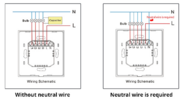That's fine, I like the way I automate things in the house with smart plugs. My question is if it's possible do it with my wiring. Thanks
Yes, I have already told you of a switch two wire which will work.
There are many ways to do basic the same thing. Smart bulbs, smart relays, smart switches, timers, PIR's, will all give you a timed on/off control of some type.
Main change is default state after power cut;-
* Smart bulb default normally on.
* Smart switch default normally off except for TP-link which does not change.
* Smart relay not tested.
* PIR some are set by switching on/off, but in the main unchanged.
* Timer most will run slow i.e. will be power time behind rear time, some are battery backed.
Since no neutral at your switch, you are limited, I started with Energenie Mihome smart switches, sockets, socket adaptors, and TRV's with a power cut the light switch auto turns off, it needs a load of 5 watt, so remove bulb and auto switches off, it only has 3 time slots although can use IFTTT to get more, it makes some bulbs flicker, and some will not switch fully off, they stay on dim, it can be paired to up to three remote controls which do not need the hub, they work direct, I started using them in around 2018 and I have now had to remove a few which seemed to turn into flasher units, but light switches and sockets, out of 5 light switches now down to 2. But it is one of the few which work with PC, many only work today only with a smart phone emulator with the PC which I find very slow.
There are other that will work without a neutral, they need to work with very low power, so think they all require a hub, as to use the wifi direct needs more power, they get the power in the main by passing a very small current through the bulb even when switched off, the TP-Link is the odd one out which uses a battery, which can be changed without removing whole switch. So gradually I have been moving over to TP-Link now had 4 of them.
One way to reduce the current through the bulb when off, is with a load capacitor, the switch
@foxhole shows uses this idea

cables to switches have two wires in close proximity, and can form a capacitor allowing some current flow when switched off specially when two way switching is used, so every LED bulb has a leak resistor to stop them glowing dim or flashing when switched off, but some bulbs are rather small, and the built in leak off is not big enough, also when on, some bulbs can react with the electronics in the switch, and start to shimmer, I had a problem with wife's bedroom light, and now have quite a stock of G9 bulbs where different ones tried until found a make and model which had no shimmer.
The light switch with battery does not have this problem, it could switch 12 volt if I wanted, it works just like a mechanical switch.